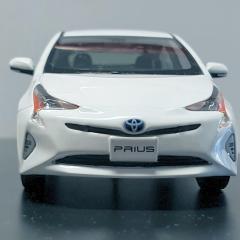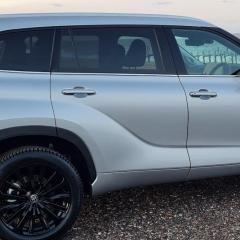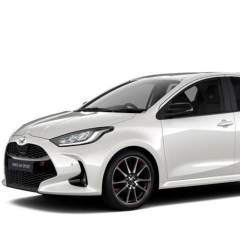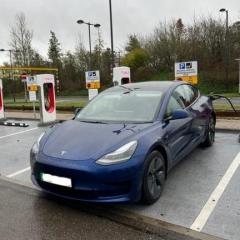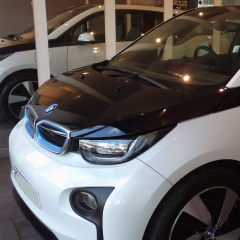Leaderboard
Popular Content
Showing content with the highest reputation on 08/20/2018 in all areas
-
The BM kits don't always have gaskets - you will be able to match up to the old ones if there is an exhaust fitting centre nearby - but given the cost, I'd simply order from Toyota. The two bolts with long plain shanks are for the connection to the exhaust. They're fitted with springs (use the old ones) to give some flexibility. The three nuts are for the heat shield studs. I'd be inclined to leave the lambda sensors at this stage - if being fitted by a garage, they will be able to check for correct response when the job is done - and in any event you're not experiencing cat issues currently. With respect to the cause of failure - DPF's do have a finite life. Other causes of failure include inadequate driving regime for regeneration and excessive engine oil consumption.1 point
-
Cat was delivered to me in Lisbon at 9am this morning 🙂 So really prompt service. No frills packaging (in bubble wrap within a cardboard box), minimum documentation, but the BM model number is stamped on it. "Free fitting kit" is two rather strange bolts and three nuts (does that sound right?); no gaskets, which I'm a bit surprised about. I'd need to go and get gaskets from Mr T. A generic note about DPFs saying firstly you must identify the reason your old one went, eg any engine defect or air leak that causes rich fueling, and secondly that replacing the lambda sensor may be a good idea. I'm following another marque (petrol engine) discussion on another forum, where someone's been trying to track down a rough-running car for months, primarily because of an air leak. Having now located the DPF in my engine bay (rear centre) and considering the awful access plus the cautions about air leaks, I've chickened out at least for a bit; would prefer to pay someone 1-200 euros to do it properly who has diagnostics etc. (This might be a good idea; decided instead to change the chainset on my wife's bike, screwed in the crank extractor, wondered why it wouldn't tighten much to push the crank off; then realised I hadn't taken the nut off the axle first... 🙃 It was 28C last night and I didn't sleep, that's my story and I'm sticking to it...) TBC...1 point
-
Yes, here you go: https://www.amazon.co.uk/gp/product/B01GHR36VY/ref=oh_aui_detailpage_o00_s00?ie=UTF8&psc=11 point
-
The Yaris is pretty good on the computer vs. reality, also showing about a 5% optimistic reading (interestingly, this is about what the speedometer is over-reading by too, so I think the actual fuel metering is very accurate). If I get the computer reading 65+ after a journey, I'm happy. Over 35-odd miles I can get it reading over 74 MPG, but that is very journey/route specific. Even if the cars don't hit the book figure all the time, show me another car that can do this milage with such little fuel usage??? 😄 Generally, the longer the journey, the happier she is. Just recently I started doing a regular run of 50-odd miles, and I'm hitting the high 60s/low 70s. On very long journeys (300 miles) I get about 70 MPG (real; 75 indicated). Fuel usage is 14.5 L on such a run, so she can do about 600 miles on a tank (7.5 gallons) under favorable conditions. A major point is to absolutely completely and totally (hyperbole much? 😛 ) avoid the power band, and even one tick mark below that. That and steady cruising at around 53 MPH, and she'll go forever on nothing. I've also found driving at 40 MPH or so is best for the first minute or three of the warm-up period. More experimentation required, but so far I have actually consistently noticed it does well when I've done this.1 point
-
I've just traded in a 3 year old Lexus IS300h for a 2018 model Rav4 Design AWD. I've yet to fully get to grips with the Rav4, however some comments about the Lexus - I got the Lexus 2 years ago after having had 2 previous Prius (which I loved). The Prius were company cars... I decided to leave the company scheme & was looking for a comparable car to buy. 2 years ago the new Prius was out of the running thanks to the "armitage shanks" cupholders and centre console. A year-old Lexus seemed a good alternative - trading up to "a Prius on steroids" with similar running gear but the 2.5 litre engine. Overall the Lexus was comfy and nice to drive. Not as economical as the Prius (not surprising). There were 2 big down-sides to the Lexus: 1) poor luggage space - but then I've had estates and hatchbacks for years - this was the first saloon for a long time. Heading for the airport we couldn't fit 2 big suitcases in the boot. Other odd shaped loads were also problematic. More importantly, 2) the Lexus had absolutely no grip on a slippery surface. I got stuck at least twice on muddy fields & ended up carrying a tow rope at all times "just in case". Whereas the Prius was fun in snow, the Lexus just got stuck! Hopefully with AWD in the Rav4 I shouldn't have this problem again. Driving the Rav4 seems to be OK (only done about 80 miles so far!) though indications are that fuel consumption will be down on the Lexus. A trivial niggle with the Rav4 is the poor location of some of the switch-gear - its a bit of a stretch to get to the EV/Eco/Sport buttons. Also the USB and power sockets are in full view in the centre console - they'd be far better located inside the centre armrest storage box, keeping phones and iPods out of sight.1 point
-
This is the N. American market https://www.toyota.com/upcoming-vehicles/RAV4/ This should give you an overall idea but expect that there will be differences for the European market e.g. probably different infotainment systems. I believe that the 2.5l ICE used in the hybrid is expected to be improved over the old version. https://www.autocar.co.uk/car-news/motor-shows-new-york-motor-show/2019-toyota-rav4-be-more-proper-suv-predecessor1 point
-
I have been getting a distinct 'ptatta ptatta ptatta' chuff from the exhaust, exactly as it fires up 🤔 My trusty ATS Wallsend, who fitted my new front section, were visited [they have a body lift!!] and opinions sought.... 😮 I have a distinct hole, right on the sleeve where the under floor cross pipe kinks up and joins the back box/over axle. ..... a finger of Exhaust Paste has been applied and we left it ticking over for 5mins to set.... OK 4 NOW 😋 *looks like this ..... expert opinion is that we have a couple of years left in the whole assembly but a 'wrap n bodge' is called for... *should look a bit like this I shall back up onto my ramps and do the tin can + wormclip + exhaust putty 😎 I have bought some gummy-tape, on line (car plan MSB 111) Good thing is that the Toyota pipe is well secured and is unlikely to snap... just rot through... 2sav1 point
-
Agreed - I have yet to find a car that I can't average the NEDC combined measure on an extended journey, but it definitely takes the right technique, the right road, the right weather and a healthy dose of luck! I came very close to averaging the 70.6mpg NEDC for the 17" Gen3 over a whole year, but that did take a certain amount of dedication to the cause. I think hitting 235mpg in a Plug-In over the year might be a challenge but I should be on electric for nearly 50% of the miles, which I think is similar to the NEDC test so who knows? Once I finally find a car to buy, I'll give it a good go!1 point
-
The Gen4 improvements in efficiency do look to be genuinely impressive in the real world, regardless of whatever the WLTP or NEDC might say. Although I'll be sorry to see the NEDC measurements go - I found part of the fun of owning a car like the Prius was the challenge of trying to match those artificial mpg numbers!1 point
-
Today I have owned my 66 plate Gen 4 for exactly 4 weeks, so I thought I would put some fuel in. When I filled up after leaving the dealer, I kept pressure on the trigger until it clicked off, waited a few seconds then squeezed the trigger again until it clicked - tank full. Today I did exactly the same procedure. Result was 34.14 litres in 602 miles. Changing this to mpg and it comes to 80.16 mpg. At that point the dashboard was showing 80.4 mpg - not a massive difference and about .15% discrepancy.. Very happy with that. Of course, after another 600 miles (or whatever) and the reading becomes more accurate.1 point
-
You can go through some menus and switch off the various updates on the left MFD one by one (so if you want to keep one or two, you can). Dirt hasn't affected my Adaptive CC at all, but a surprisingly small amount of snow stops it working completely, and presumably renders the AEB inoperative too! Very (and I mean very) heavy rain can stop it working too. The ACC does look where you steer, but there is a slight delay when the car in front moves out of it's field of 'vision' before you start to steer yourself. That can cause the car to momentarily start to accelerate and then stop doing so as you steer slightly later and reacquire the 'target'. The effect is very slight, but I've adapted my steering to steer very slightly earlier to try to keep the car in front in view a bit more. To be fair, the manuals tell us to only use it on fairly straight "freeways", but that's a bit like telling Tesla Autopilot users to keep their hands on the steering wheel at all times! I'd challenge you to find the auto dip switch while negotiating some of the twisty, highly embanked single track lanes near me when you're turning the steering wheel like a stop ***** on the Queen Mary in pitch black conditions, while being unable to accelerate enough to get them to come on automatically (27 mph) without having high beams on to see the banks. Even pulling to stalk to operate the flasher is not easy, I just find it safer to leave them permanently off.1 point
-
At the moment I am driving in Germany, with the warmer temperatures ev and ev mode is lasting longer than back home. Having the aircon on has a big impact though. Sent from my iPhone using Tapatalk1 point
-
Had ours serviced yesterday, and they asked me if I would like them to wash it. I said, "Yes please, and if they could clean the inside and put the vacuum cleaner it there too that it would be nice." They did ................ and the car was like a new pin when I picked it up. 🙂 Mick.1 point
-
Hello PeteB, What kind of voltage do you get in Accessory mode? Mine starts at 12.0v and drops to 11.7-11.8 in about 45 seconds. But when I turn the Start to ON I get a steady 13.8v Reading on the web, it says a healthy battery should output 12.6v in accessory mode and anything from 13.8-14.7 when running. Would you think my battery is a bit on the low side? I've made a little clip and uploaded it to youtube here. The text tells you what is happening (no sound).1 point
-
My average is now moving back to 65mpg - our cars seem to like temps around 20C.1 point
-
I've recorded every single fillup in all 7 Prius I've owned since 2002 for over 300,000 miles and logged them in a database where is also record the B trip MPG, resetting B at the time of each fill. The database shows me the actual mpg, difference in mpg and %. On all versions the % varies between about 2% and 8% but roughly on average about 5% seems right, so that's what I deduct from any displayed figure.1 point
-
I see the figure on the dashboard, I know its not strictly correct, and so do majority of punters on here, so each can deduct what they want - I still very happy with the figure shown.1 point
-
1 point
-
The 700W number is interesting. My commute home is 15 miles and takes about 30 minutes. I typically get 65mpg to 72mpg in moderate weather. There is 9.6 kWh per litre of petrol. 65 mpg is 1/65 = 0.0154 gallon per mile 1/65 / 0.22 = 0.0699 litres per mile 1/65 / 0.22 * 9.6 = 0.6713 kWh per mile 15 mile trip uses 15 * 0.6713 = 10.0695 kWh 30 minutes of AC at 700W = 0.35 kWh Petrol to electric efficiency is probably about 1/3 so approximately 1kWh for AC. This is approximately a 10% decrease in efficiency and 65 mpg goes down to 58.5 mpg if the AC is on fully. This is consistent with what I see in really hot weather.1 point

